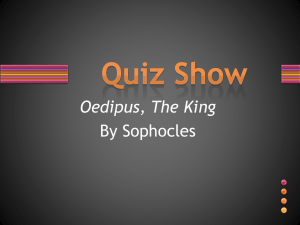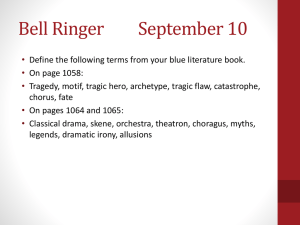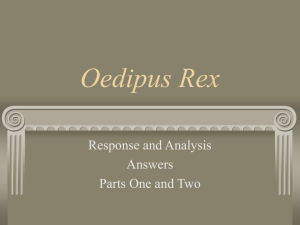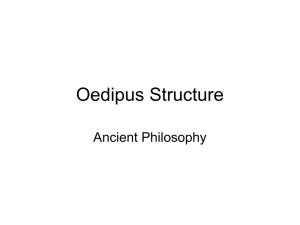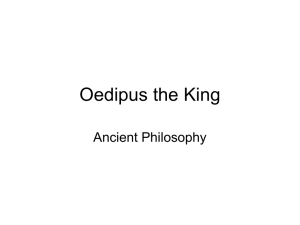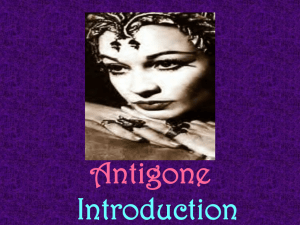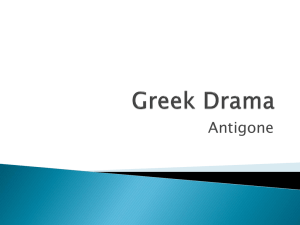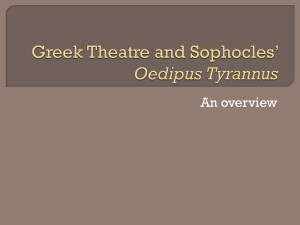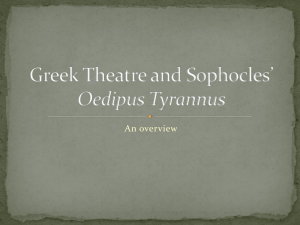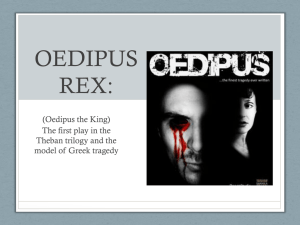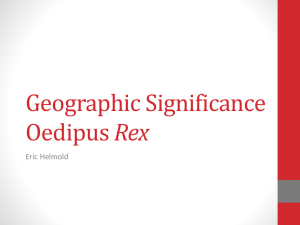Oedipus Rex Power Point
advertisement
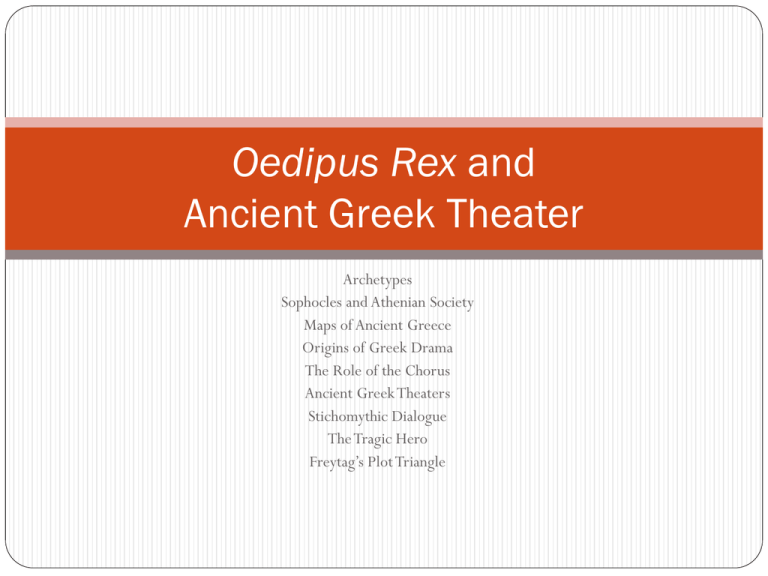
Oedipus Rex and Ancient Greek Theater Archetypes Sophocles and Athenian Society Maps of Ancient Greece Origins of Greek Drama The Role of the Chorus Ancient Greek Theaters Stichomythic Dialogue The Tragic Hero Freytag’s Plot Triangle Archetypes An archetype is a basic model, a prototype, a paradigm, an exemplar. An archetype is atavistic and universal; it is a product of the “collective unconscious.” Fundamentals of Human Existence • • • • • • • • Birth Growing up Death Love Family Tribal life Sibling rivalry Generational conflict Creatures and Symbols • • • • • • • Lion Eagle Snake Tortoise Hare Rose Paradisiacal garden Character Types • • • • • • • • • The rebel The “player” The “femme fatale” The self-made man The all-conquering hero The traitor The villain The god-king The king as a sacrificial scapegoat • The tragic hero Sophocles (497 or 496 to 406 B.C.) Sophocles was born in Athens. Sophocles was the best-known ancient Greek playwright. While Sophocles was a member of the ruling class, he was aware of the social inequalities in Athenian society. Sophocles used his plays to warn his fellow Athenians of “divine retribution” for social injustice. Sophocles explored the fate-freewill dichotomy in his plays. While humans eventually have to face the consequences of their decisions and actions, freewill was not more powerful than fate or destiny. In fact, one’s freewill could actually work toward fulfilling fate! Mt. Olympus Pisa Origins of Greek Drama Sixth Century B.C. o Thespis essentially invented acting by stepping in front of the chorus and performing a solo. o Thespian has come to mean actor. Fifth Century B.C. o Each year plays were performed in an annual competition to honor Dionysus o o o o (Bacchus). Each playwright wrote three tragedies and a satyr-play (a farce for comic relief) for the competition. Sophocles won twenty of these competitions. Sophocles introduced the third actor on stage. (Aeschylus introduced the use of the second actor on stage.) Sophocles Theban plays, while often anthologized together, were actually not originally written as a trilogy. In fact, Antigone was written first, Oedipus Rex was written second, and Oedipus at Colonus was written last. The Chorus Group of 15 men who sang lyric poetry and danced to music Unpaid and drawn from the citizenry at large Considered a civic duty Costumed in light masks and the dress of the people Link between audience and actors o Served as the “ideal spectator,” responding to the play as the playwright intended. o Functioned as the conscience of the people, establishing an ethical perspective from which to view the play Reflected upon what had happened and foreshadowed what was to come Questioned, made requests of, and at times advised the central characters Helped to establish mood and heighten dramatic moments Helped to establish pacing Provided tension release Separated the scenes Performed in song with a back-and-forth movement that heightened the emotion of the performance Strophe (left to right) Antistrophe (right to left) Epode A character or characters onstage interacted with the Chorus through a song, the kommos, or through a leader or spokesperson, the Choragos, who would step forth from the Chorus to become a character on stage. Stichomythic dialogue (stichomythia): Alternating individual lines of verse between two speakers A technique used to provide contrast to long speeches A technique used to present thesis and antithesis, questions and answer, argument and refutation. A technique that allowed playwrights to distinguish for the audience one masked actor from another A technique used to heighten the drama Usually occurs at moments of high tension Usually structured in parallel lines of verse Sometimes structured using antilabe The Crime of Laius (Laios): Pelops: King of Pisa, husband of Hippodameia, father of Chrysippus (from a previous marriage), Atreus and Thyestes, among others. Laius took refuge in Pisa after fleeing Thebes; his older cousins (Amphion and Zethus) ruled Thebes at the time, and he feared for his life. Pelops welcomed Laius and entrusted him with the training of Chrysippus in the art of war and charioteering. Antiope, mother of Amphion and Zethus, was raped by Zeus. Amphion married Niobe, who bragged about her many children and insulted the goddess Leto. Leto’s twins, Apollo and Artemis (fathered by Zeus), killed all Niobe’s children in retaliation. Amphion either killed himself or was killed by Zeus after vowing revenge, and Niobe either killed herself or was turned to stone. Zethus had only one son, who died, so he killed himself. Laius fell in love with and abducted Chrysippus, taking him back to Thebes once the “coast was clear.” Pelops gathered his army and marched to Thebes to retrieve his son, but Hippodameia conspired with her two sons, Atreus and Thyestes, to kill Chrysippus (in some versions Chrysippus kills himself out of shame). Pelops banished Hippodameia, Atreus, and Thyestes to Mycenae, where Hippodameia hanged herself and Atreus became king. Laius, having angered Pelops and the gods with his behavior, was cursed by Pelops and warned by Apollo not to have any children. Hera also sent the Sphinx to torment Thebes. Laius, being motivated by passion more than reason, did not heed Apollo’s warning and had a son with Jocasta (Iocaste)—Oedipus! As far as Atreus and Thyestes are concerned, Atreus became king of Mycenae and Thyestes seduced Atreus’ wife. Atreus retaliated by serving Thyestes’ two sons to him at a “reconciliation” dinner. Thyestes cursed Atreus and his two sons, Agamemnon and Menelaus. Sound familiar? Menelaus was the king of Sparta and husband of the infamous Helen, the reason (mythologically speaking) for the Trojan War! Agamemnon was king of Mycenae and fought with his brother in the Trojan War. According to legend, both survived the war and returned safely home, but Agamemnon was betrayed and killed by his wife, Clytemnestra, and her lover, Aegisthus—another son of Thyestes! Orestes avenged his father’s murder, which is the subject of Aeschylus’ trilogy Oresteia. Paradox: A seemingly contradictory statement, which upon further analysis makes sense; that which sounds impossible but is actually possible; a side-by-side play on contradictory ideas that clash and reconcile simultaneously. “Water, water everywhere, but not a drop to drink.” “It’s the little things in life that are colossal.” “Stone walls do not a prison make.” “None so blind as those that will not see.” Paradox of blindness! By exercising freewill, Oedipus fulfills his fate! Tragic Hero He is elevated to a high status and position in society, and he possesses noble stature and greatness. While he embodies nobility and virtue, he is flawed. His downfall or demise is due in part to freewill, an error in judgment (i.e., hamartia) associated with a tragic flaw (e.g., hubris). His downfall or demise is due in part to fate. His misfortune is not wholly deserved; the punishment exceeds the crime. He gains awareness, insight, and self-knowledge as a result of his fall from grace. Tragedy An action of great magnitude is at the center of the plot. Pathos (that which evokes pity or sympathy) is an essential element of the play. The plot is carefully sequenced, moving from the complication to the unraveling or denouement. Complication: Prologue to turning point Denouement: Turning point to the resolution Complicated plots involve reversal (peripeteia), which is a sudden change or reversal of circumstance or fortune, and recognition (anagnorisis), which is a change from ignorance to knowledge. A catastrophe occurs, which usually spirals outward: not only does the tragic hero suffer, but his family also suffers. A catharsis (a purification or purging of emotions; a spiritual renewal) occurs. Prologue, Parodos, Scene I, and Ode I (3-26): Text-dependent Questions How does the Priest try to appeal to Oedipus? How does Oedipus respond? What is (are) Oedipus’ motive(s) for finding the murderer? What riddles does Teiresias share with Oedipus? How does Oedipus respond? What is ironic about his response? What has been revealed about Oedipus’ possible tragic flaw and hamartia? Find an example of stichomythia? How is it being used? What is its effect? Prologue and Parodos (3-12): Important Quotes Priest: “You are not one of the immortal gods, we know;/Yet we have come to you to make our prayer…/…You saved us/From the Sphinx…/…yet you were never/Better informed than we, nor could we teach you:/It was some god breathed in you to set us free” (5). Oedipus: “Sick as you are, not one is sick as I./Each of you suffers in himself alone/…but my spirit/Groans for the city, for myself, for you” (5). Creon: “Is it your pleasure to hear me with all these/Gathered around us? I am prepared to speak,/But should we not go in?” (7) Oedipus: Let them all hear it./It is for them I suffer, more than for myself ” (7). Creon: “The riddling Sphinx’s song/Made us deaf to all mysteries but her own” (9). Oedipus: “Then once more I must bring what is dark to light” (9). Oedipus: “By avenging the murdered king I protect myself ” (9). Scene I and Ode I (12-26): Important Quotes Oedipus: “Thus I associate myself with the oracle/And take the side of the murdered king” (14). Oedipus: “As for the criminal,…/…I pray that the man’s life be consumed in evil and wretchedness./And as for me, this curse applies no less…”(14). Oedipus: “Their son would have been my children’s brother,/If Laios had the luck of fatherhood!” (14) Oedipus: “I say I take the son’s part, just as though/I were his son, to press the fight for him/And see it won!” (14) Teiresias: “How dreadful knowledge of the truth can be/When there’s no help in the truth!” (17) Teiresias: “Let me go home. Bear your own fate, and I’ll/Bear mine. It is better so: trust what I say” (17). Teiresias: “When it comes to speech, your own is neither temperate/Nor opportune. I wish to be more prudent” (17). Teiresias: “You are all ignorant./No; I will never tell you what I know./Now it is my misery; then, it would be yours” (18). Teiresias: “What does it matter!/Whether I speak or not, it is bound to come” (18). Oedipus: “Then, if ‘it’ is bound to come, you are bound to tell me” (18). Teiresias: “No, I will not go on. Rage as you please” (19). Oedipus: “I’d say the crime was yours, and yours alone” (19). Teiresias: “You yourself are the pollution of this country” (19). Teiresias: “I say that you are the murderer whom you seek” (20). Teiresias: “Creon is no threat.You weave your own doom” (20). Teiresias: “You mock my blindness, do you?/But I say that you, with both eyes, are blind” (22). Teiresias: “This day will give you a father, and break your heart” (24). Oedipus: “Your infantile riddles!” (24) Teiresias: “A blind man,/Who has his eyes now; a penniless man, who is rich now; /And he will go tapping the strange earth with his staff/To the children with whom he lives now he will be/Brother and father…to her/Who bore him, son and husband…” (25). Chorus: “Shall I believe my great lord criminal/At the raging word that a blind old man let fall?/I saw him…/Prove his heroic mind! These evil words are lies” (26) Scene II and Ode II: Hope What does it mean to have hope? What is the difference between hope and faith? At the end of scene two, Choragos says, “But there is hope: you have yet to hear the shepherd” (44). To this Oedipus replies, “Indeed, I fear no other hope is left me” (44). Then in Ode II, the Chorus says, “The tyrant is a child of Pride/Who drinks from his great sickening cup/Recklessness and vanity,/Until from his high crest headlong/He plummets to the dust of hope” (46). Based on these lines, what does Sophocles seem to be suggesting about hope? Explain. Read the following poem by Emily Dickinson and the following quote by Patrick Henry. What does each author seem to be suggesting about hope? How do their interpretations of hope compare to that of Sophocles? Explain. Emily Dickinson “Hope” is the thing with feathers— That perches in the soul— And sings the tune without the words— And never stops—at all— And sweetest—in the Gale—is heard— And sore must be the storm— That could abash the little Bird That kept so many warm— I’ve heard it in the chillest land— And on the strangest Sea— Yet—never—in Extremity, It asked a crumb—of me. Source: The Poems of Emily Dickinson Edited by R. W. Franklin (Harvard University Press, 1999) Patrick Henry from “Speech to the Virginia Convention” (“Give Me Liberty Or Give Me Death!”), delivered in Richmond, Virginia, on March 23, 1775 Our petitions have been slighted; our remonstrances have produced additional violence and insult; our supplications have been disregarded; and we have been spurned, with contempt, from the foot of the throne. In vain, after these things, may we indulge the fond hope of peace and reconciliation. There is no longer any room for hope. If we wish to be free² if we mean to preserve inviolate those inestimable privileges for which we have been so long contending²if we mean not basely to abandon the noble struggle in which we have been so long engaged, and which we have pledged ourselves never to abandon until the glorious object of our contest shall be obtained, we must fight! I repeat it, sir, we must fight! Source: Wirt, William. Sketches of the Life and Character of Patrick Henry . (Philadelphia) 1836, as reproduced in The World's Great Speeches, Lewis Copeland and Lawrence W. Lamm, eds., (New York) 1973. Scene II and Ode II: Text-dependent Questions How are Oedipus and Creon foils? Provide evidence from the text for support. According to legend, who killed Laios and where was he killed? (38-40) What realization does Oedipus have regarding the murder? Why? (38-40) What is Oedipus’ backstory? Where was he living before arriving in Thebes? Why did he leave this place? (41-44) How are Oedipus and Iocaste foils? Provide evidence from the text for support. Oedipus Rex Summation: Prologue-Ode II (3-47) What might Oedipus’ tragic flaw be? Provide evidence from the text for support. What errors in judgment (also known as ________________) does Oedipus make? Provide evidence from the text for support. How would you rate Oedipus as a leader? Explain. Scene III and Ode III (47-59) What news does the messenger from Corinth bring regarding Polybos? How does Oedipus react? What is ironic about his reaction? Why does he react this way? What does the messenger reveal about Oedipus’ birth? How do Oedipus and Iocaste react? What is ironic about Iocaste’s reaction? Why does she react this way? How does Oedipus interpret Iocaste’s reaction? This scene is the peripeteia, or the reversal of fortune: Oedipus learns that Polybos is not his biological father, so the prophecy may still come true! How would you rate Oedipus as a leader? Oedipus Rex Summation: Prologue-Ode IV What is the difference between tragic flaw and hamartia? What might Oedipus’ tragic flaw be? How is it illustrated? What is the peripeteia? When does it occur What is the anagnorisis? When does it occur? Imagery and Symbolism Goal Explain how imagery and symbolism underscore theme. In other words, use details from the text associated with imagery and symbolism to make inferences about theme. Imagery/Symbolism References to Mt. Kithairon References to Light vs. Dark/Day vs. Night References to Sight vs. Blindness References to the Number Three Tasks In small groups of three to four: 1. Cite two to three direct references from the text with page numbers! 2. Identify a common theme that the direct references illustrate! 3. Explain how each of the direct references illustrates this theme! 4. Draw a picture that illustrates how imagery and symbolism underscore theme! In two “jigsaw” groups share your results! Roles Artisan Liaison Orator Page Master Imagery and Symbolism Step 1 (Small groups of five according to color and imagery/symbolism): Group 1: References to Mt. Kithairon Group 2: References to Light vs. Dark/Day vs. Night Group 3: References to Sight vs. Blindness Group 4: References to the Number 3 Step 2 (Jigsaw groups according to color): Group 1: Blue Group 2: Orange
